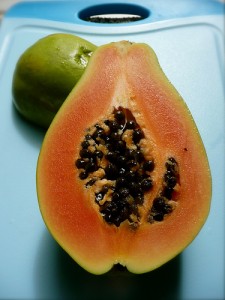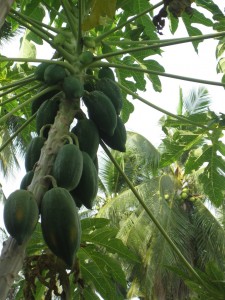Scientific Name: Carica papaya
Genetically Engineered Trait: Resistance to the papaya ringspot virus
Details of Genetic Engineering:
In the 1990s papaya ringspot virus was in the process of wiping out the Hawaiian papaya industry, then the second largest fruit industry in Hawaii. Conventional approaches such as selective breeding for resistant papayas or attempting to grow trees in isolation had failed. The virus is transmitted by small sap-sucking insects such as aphids. Infected papaya trees can be recognized by the discolored rings on their fruit (that the virus gets its name from) yellow leaves, and most importantly from a papaya farmer’s perpsective a 60-100%* loss of fruit production.
Resistant papayas were created by a collaboration between the USDA and the University of Hawaii (with help from Cornell University where the early versions of ballistic transformation** were being developed at the time) by giving papayas a gene from the papaya ringspot virus itself. It worked. Resistant papayas are so successful that they’re used to protect organic papayas from the virus. (second half of the article)
Another point to keep in mind in this case is since the transgene introduced into GE papayas to protect them from viral infection came from the papaya ringspot virus and many organic papayas are still infected with the virus, the average organic Hawaiian papaya has HIGHER concentrations of the papaya ringspot virus protein than the unnatural genetically engineered ones***
About Papayas:
The papaya was originally domesticated in central America, and is now grow around the world. Papaya’s actually have a high concentrations of an enzyme that breaks down proteins called papain. A sufficiently concentrated extract might be able to dissolve flesh (though I don’t know that anyone has tried it) and that ability is showcased in the use of unripe papaya juice to tenderize meat.
Special Bonus Section:
While transgenic papayas have been a huge hit in Hawaii, their adoption in the rest of the world has been quite slow. Because the papayas are the product of non-profit and government agencies, there’s no one with a profit motive in their adoption, and leaving local agricultural advocates and researchers outnumbered and outspent by anti-GMO NGOs that draw most of their financial support from Europe. A great case study of the problems they face was presented a year and a half ago in Plant Physiology: “Forbidden Fruit: Transgenic Papaya in Thailand” It’s well worth a read as both a fascinating story in it’s own right, and an example of the tactics that can be used against genetic engineering when scientists aren’t engaged enough to act as a check on misinformation. To close my profile on papaya, let me quote the conclusion of that article:
It is time to meet the press. Although scientists are not generally trained in media communication, who is better qualified to discuss the risks and benefits of GE crops? If scientists do not undertake this task, where will the public get its information?
If the next generation of biotechnology crops is to make an impact on those who arguably have the most to gain and have yet to reap the benefits of the first generation—those of the developing world—then it is time for plant biotechnologists to move beyond the bench, kick around in some barren soils, man a water buffalo for a day, meet the people whose lives will be impacted, and display the same amount of passion for having their technology used in the field as they have for developing it in the laboratory. It is time to get organized, get political, get heard, and get out of the lab. Otherwise, the fruits of this fascinating research may remain forbidden.
*Losses of production per country or per region are often much greater. If papayas are less productive, fewer people will choose to grow them, so increasing yield per plant actually has a multiplicative effect as more people get back into the growing papayas.
**The original gene gun was basically a modified .22 caliber rifle. The principle of a gene gun is basically if you throw DNA hard enough at a layer of cells some of it will end up in the nucleus and get incorporated into chromosomes by natural repair mechanisms. And the crazy thing is that it actually works!
***This is an old statistic, that I believe dates from before genetically engineered papayas were incorporated as a layer of protection around organic papaya production. (The idea is aphids traveling towards the organic papayas will first reach the virus resistant papayas, bite them where the virus is ineffective.)


Hey James,
This is a great series. I was wondering if you had or know of a good list of all the transgenic crops and/or transgenes that are on the market or even in testing etc. Just looking for a localized resource.
Thanks a ton!
Comment by Greg — November 12, 2009 @ 4:44 pm
I’m glad you’re enjoying it.
It’s a good question and I haven’t been able to find a single definitive resource, though I’m sure they do exist. One you might find useful is this list, however it’s both incomplete (I think it only includes products produced by members of the biotechnology industry organization, inaccurate (I can’t find any outside confirmation for the products on that list developed by Mycogen) and out of date (sugar beets resistant to glyphosate have been both released and sued off the market but as still listed as in development).
Any other readers have better suggestions?
Comment by James — November 12, 2009 @ 5:04 pm
That would be a helpful list. I hear all the time “nobody can buy any seeds that aren’t GMO” and then I ask for a list of what they have been unable to obtain.
I never get it.
It would be fun to have the list of existing products and ask them if this is all they intend to grow.
Comment by Mary — November 12, 2009 @ 8:59 pm
Well the idea of this series is that at the end I’ll have a list of every crop known to be genetically engineered (not that many). And anyone who claims something else is genetically engineered will have to provide sources to back themselves up.
Comment by James — November 12, 2009 @ 10:09 pm
Yeah, I get that “nobody can buy seeds that are not GM” I am quick to respond that growing up on a seed corn farm and knowing the industry fairly well, there are defiantly non-GM varieties available(often the only difference is the GM trait). Admittedly there is more incentive to sell the GM lines. If a farmer wants non-GM seed (and I can only really speak to Ag in Ontario) and is semi-competent, they can get it.
Goes to show how much misinformation on this subject there is.
thanks for the link, i think it will be very useful.
Comment by Greg — November 13, 2009 @ 10:57 am